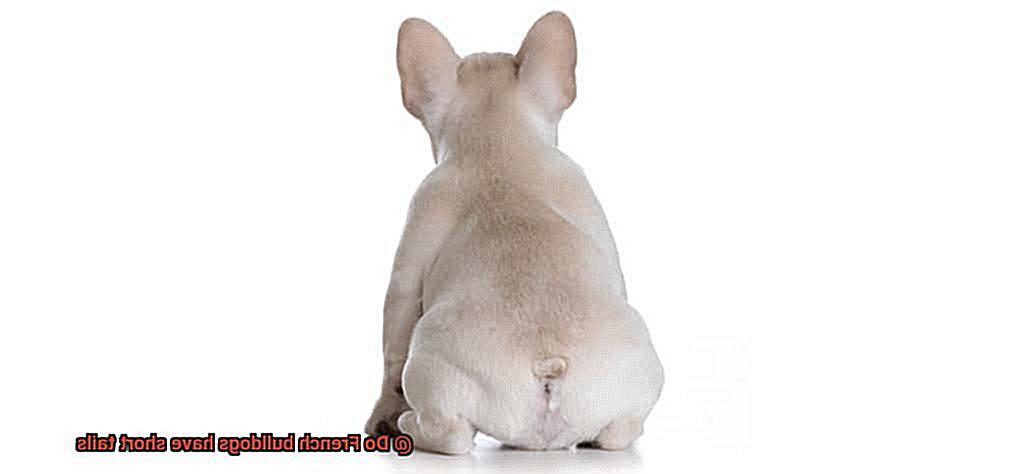Do French bulldogs have short tails?
French bulldogs, those irresistible bundles of charm and cuteness, have a little secret hidden behind their wagging butts.
Yes, you guessed it right – their tails are short and stubby. Unlike other dogs with long, flowing tails that can knock over everything in sight, Frenchies sport a unique tail structure that adds to their already adorable appearance.
So get ready to uncover the fascinating tale behind the French bulldog’s tail.

What is a French Bulldog?
Contents
- 1 What is a French Bulldog?
- 2 Why Do French Bulldogs Have Short Tails?
- 3 How Long Are French Bulldog Tails?
- 4 The Function of the Short Tail in French Bulldogs
- 5 Is the Short Tail of French Bulldogs Natural or Surgically Created?
- 6 The Genetics Behind the Short Tail in French Bulldogs
- 7 Variations in the Length and Shape of the Tail
- 8 Conclusion
These beloved companion animals are the perfect choice for families and individuals seeking a loyal and affectionate furry friend. Among their many endearing qualities, the French Bulldog’s short, curled tail stands out as a defining characteristic. In this article, we will explore the fascinating world of French Bulldogs and uncover the enchantment behind their special tails.
A Brief History:
Originating in France during the 1800s, French Bulldogs were initially bred to accompany lace workers in Nottingham, England. Their friendly nature and striking appearance, including their unmistakable short tails, soon gained them recognition and popularity.
The Curled Tail:

Unlike some other breeds where tails are surgically docked, French Bulldogs possess a naturally short tail inherited from their ancestors, particularly the English Bulldogs. Typically measuring only one to two vertebrae long, these adorable tails complete their irresistible look.
Purpose and Function:
The short tail of a French Bulldog serves both functional and aesthetic purposes. Despite their compact bodies, it helps maintain their overall balance and stability while moving, showcasing their surprising agility. Moreover, the curled shape adds an extra touch of endearment to their already captivating appearance.
Less Prone to Injury:
Compared to longer tails, the shorter length of the French Bulldog’s tail makes it less susceptible to accidents or injuries. This is particularly advantageous in households with young children or other pets, as the risk of stepping on or catching the tail is significantly reduced.
Individual Variations:
While most French Bulldogs possess short, curled tails, there can be slight variations in length and shape among individuals. Some may exhibit slightly longer tails that maintain the characteristic curl, while others may have tails even more compact in appearance. Each dog’s tail is uniquely charming, adding to the overall personality of the breed.
Why Do French Bulldogs Have Short Tails?
Today, we embark on a journey to unravel the mystery behind those adorable, short tails that grace our beloved furry companions. Have you ever wondered why French Bulldogs have such unique tails? Let’s dive in and explore the fascinating reasons behind this distinctive trait.
Selective Breeding: Creating a Distinct Appearance
French Bulldogs’ short tails are not simply a result of chance; they are intentionally bred to maintain the breed’s desired appearance. Through decades of careful breeding, breeders have aimed to create a specific look for French Bulldogs, resulting in their signature straight and tapered tails that make them stand out from other breeds.
Practicality: Safety First.
The short tail of French Bulldogs serves a practical purpose – it reduces the risk of injury. With their stocky build and low center of gravity, French Bulldogs are prone to accidents or falls. A shorter tail minimizes exposure and provides an extra layer of protection, ensuring that our playful and mischievous Frenchie friends can roam around without worry.
A Companion’s Compactness: The Perfect Fit
French Bulldogs were originally bred as companions to lace workers during the Industrial Revolution, and their short tails contribute to their overall well-balanced appearance. Their compact size and easy-to-care-for coat made them ideal for this role. The short tail enhances their compactness, making them the perfect fit for their historical role as loyal companions.
Facial Expressions in the Spotlight
One cannot help but fall head over paws for those expressive eyes and wrinkled face that are characteristic of French Bulldogs. With a shorter tail, the posterior region takes a backseat, allowing their captivating facial expressions to shine even brighter. It’s this attention to detail that adds to their irresistible charm and makes them highly sought after as pets.
How Long Are French Bulldog Tails?
These charming canines are renowned for their unique appearance, and their short tails are no exception. Join me as we explore the nuances of French Bulldog tail length and unravel the mystery behind why these delightful pups sport such petite posterior appendages.
The Average Length:
On average, French Bulldog tails measure between 1 to 2 inches in length. However, it’s important to note that slight variations can occur due to genetics and breeding practices. While most Frenchies boast this standard tail length, it’s not uncommon to encounter individuals with slightly longer or shorter tails, adding to their distinctiveness.
Genetics and Breeding:
Just like us humans, our furry friends inherit certain traits from their parents. The length of a French Bulldog’s tail is influenced by genetics, which explains the subtle differences we observe among these lovable canines. Responsible breeders meticulously select mating pairs to preserve the breed’s desirable traits, including the characteristic short tail.
Practicality and Well-being:
As we delve deeper into understanding French Bulldog tail length, we realize that there’s more than meets the eye. The short tail serves a practical purpose beyond aesthetics. Through years of selective breeding, this unique feature has evolved to prevent potential health issues associated with longer tails. By having a shorter tail, French Bulldogs avoid common problems like fractures and dislocations that longer-tailed breeds may experience.
Tail Docking:
In some cases, you may come across French Bulldogs with naturally docked tails. Tail docking refers to the historical practice of removing a portion of the tail shortly after birth for various reasons, such as cosmetic preferences or working purposes. However, it’s essential to note that in many countries, natural docking is now prohibited except for specific working breeds. This shift reflects a growing understanding and appreciation for the natural state of dogs’ tails.
Embracing Uniqueness:
As proud owners or aspiring parents of French Bulldogs, it’s crucial to appreciate and celebrate their unique characteristics, including their short tails. These adorable little appendages are a natural part of the breed’s heritage and should be cherished rather than altered. Let us embrace the charm and allure of these petite posterior adornments that make French Bulldogs truly one-of-a-kind.
The Function of the Short Tail in French Bulldogs
French Bulldogs are renowned for their unique and adorable short tails, which not only add to their charm but also serve a functional purpose. Unlike some other breeds where tail length is purely aesthetic, the short tail in French Bulldogs has been naturally selected and bred over many generations to enhance their overall balance and mobility.
The compact and sturdy body structure of French Bulldogs is one of their defining features, and the short tail plays a crucial role in maintaining their stability. With their short tails, French Bulldogs have a lower center of gravity, allowing them to stay grounded and balanced even during quick movements or changes in direction.
This makes them more agile and maneuverable, enabling them to navigate various terrains with ease. Whether they are exploring the great outdoors or playing fetch in the backyard, the short tail helps French Bulldogs maintain their poise and grace.
In addition to its role in maintaining balance, the short tail in French Bulldogs is an essential tool for communication and expression. Just like humans use facial expressions and body language to convey emotions, French Bulldogs utilize their tails to communicate how they’re feeling. Despite its shorter length, the tail can still wag enthusiastically to express happiness or excitement.
It can also be held high and still to signal caution or alertness. The range of motion may be limited compared to long-tailed breeds, but French Bulldogs make the most of what they have, using their tails to convey a wide array of emotions.
For owners of French Bulldogs, understanding their dog’s mood and intentions becomes easier when paying attention to the position and movement of their tail. Observing the tail can help you gauge if your Frenchie is relaxed, playful, or even anxious.
It’s like having a built-in emotional indicator that allows you to better interpret your furry friend’s needs. The short tail becomes a visual cue that enhances the bond between dog and owner, creating a deeper level of understanding and connection.
Is the Short Tail of French Bulldogs Natural or Surgically Created?
If you’re a proud owner of a French Bulldog, you’ve undoubtedly been captivated by their adorable, short tails. But have you ever wondered if this unique feature is natural or surgically created? Let’s dive into the world of French Bulldogs and unravel the mystery behind their short tails.
Firstly, it’s important to note that the short tail of French Bulldogs is indeed a natural characteristic. These compact and muscular dogs are born with their tails naturally short and straight. This distinctive feature is a result of selective breeding over many generations. Dedicated breeders have intentionally bred French Bulldogs with shorter tails to conform to breed standards set by kennel clubs.
But what about surgical procedures like tail docking? Here’s the interesting part – tail docking, which involves removing a portion of the tail, is illegal in many countries unless it is done for medical reasons. And fortunately for our furry friends, it is not performed on French Bulldogs. So rest assured, the short tail of your French Bulldog is not surgically created.
The natural short tail of French Bulldogs serves both functional and aesthetic purposes. It allows for better balance and agility, which is crucial for a breed known for its energetic and playful nature. Just imagine your Frenchie zooming around with that wagging little tail, effortlessly navigating their surroundings.
And let’s not forget about the aesthetic appeal. The short tail enhances the overall appearance of the breed, giving them a distinctive look that we all adore. It’s like a signature feature that sets them apart from other breeds.
Now, some people may mistake the short tail of French Bulldogs as a result of surgical procedures like docking or cropping. But it’s crucial to understand that these practices are not performed on French Bulldogs and are not part of their breed standard.
While the short tail of your French Bulldog is natural, it’s important to ensure proper care and hygiene for this unique feature. Regularly cleaning your dog’s tail will help prevent any infections or irritations. During grooming sessions, take a moment to check for any abnormalities or injuries on the tail, ensuring your Frenchie stays happy and healthy.
The Genetics Behind the Short Tail in French Bulldogs
In this article, we will delve into the fascinating world of genetics to uncover the secrets behind the short tail in French Bulldogs. So, grab a cup of coffee and join us on this genetic journey.
Ancestral Link: English Bulldogs
To understand the genetics behind the short tail in French Bulldogs, we must first look back at their ancestors, the English Bulldogs. These lovable dogs possess a gene mutation known as the T-box gene, which plays a vital role in tail development during embryonic growth.
Inherited Trait:
Through selective breeding, French Bulldogs have inherited this gene mutation from their English Bulldog ancestors. Consequently, they also possess the T-box gene mutation, resulting in a shortened tail. This distinctive trait has become one of the defining features of this adorable breed.
The Corkscrew Tail:
Let’s now explore the appearance of the short tail in French Bulldogs. The T-box gene mutation causes various tail abnormalities, including short or no tails. In French Bulldogs, this mutation gives rise to a unique short tail with a slight curvature, often referred to as a screw or cork-screw tail.
Variation and Influences:
It is important to note that not all French Bulldogs have short tails. Genetic variation exists within the breed, meaning that some individuals may have longer tails than others. Furthermore, environmental factors and other genetic traits can influence the appearance of the tail in French Bulldogs.
Health Considerations:
While the short tail itself does not impact their overall health or well-being, responsible owners must be aware of potential health issues associated with this trait. If proper cleaning and hygiene are not maintained, skin irritation or infection can occur. Regular monitoring and care are essential to keep your Frenchie’s tail healthy and happy.
Breeding Practices:
When it comes to breeding French Bulldogs with short tails, responsible breeding practices are crucial. Breeding two French Bulldogs with short tails increases the likelihood of producing offspring with short tails, but it is not a guarantee. It is vital to consider the overall health and well-being of the breed when making breeding decisions.
Variations in the Length and Shape of the Tail
Join us on a genetic journey as we delve into the secrets behind their unique tails and uncover the factors that contribute to their individuality.
Short Tails, Long on Variation:
Contrary to popular belief, not all French Bulldogs have extremely short tails. While they do tend to have shorter tails compared to other breeds, there is still a range of lengths within the French Bulldog community. Some may have very short tails, while others possess slightly longer ones. This variation is determined by genetics, with specific tail length genes being passed down from parents to offspring.
Shape Matters:
In addition to length, the shape of a French Bulldog’s tail can also differ among individuals. Most French Bulldogs have straight tails that taper towards the end, but there are charming exceptions. Some may exhibit a slight curve, adding a touch of elegance to their tail, while others may boast a delightful screw-shaped tail. These variations in shape do not impact the dog’s overall health or functionality.
Genetic Influences:
The genetics behind French Bulldog tail variations are truly intriguing. Breeders who specialize in French Bulldogs aim to produce puppies with shorter tails in line with breed standards. However, genetic variations mean that not all French Bulldogs will have extremely short tails. The diversity in tail length and shape adds to the uniqueness and charm of each individual Frenchie, making them even more special.
Health Considerations:
While variations in tail length and shape are generally harmless, it’s important to note that some French Bulldogs may be born with congenital conditions affecting their tails. For instance, a kinked or twisted tail is considered a cosmetic flaw but does not pose any health concerns for your furry friend. Responsible breeders strive to minimize such conditions through careful genetic selection.
Embrace the Unique Tail Waggers:
French Bulldogs’ tails are as unique as their personalities. Whether your Frenchie’s tail is short, slightly longer, straight, or with a cute curve, it adds to their distinctive appearance and doesn’t affect their overall well-being. Embrace and celebrate the individuality of your Frenchie’s tail, as it is a testament to the genetic journey that has shaped this delightful breed.
Conclusion
To sum it up, French Bulldogs unquestionably rock the short tail look, adding an extra dose of cuteness to their already irresistible appearance. Unlike other dogs flaunting long, flowing tails, Frenchies sport a one-of-a-kind tail structure that is naturally stubby and oh-so-charming. This distinct feature has been meticulously bred over countless generations to enhance the breed’s overall balance and nimbleness.
The short tail of a French Bulldog serves both practical and aesthetic purposes with finesse. It not only helps them maintain stability while strutting their stuff but also adds an adorable twist to their captivating looks. Picture it—a curled little tail that screams “I’m cute and I know it.”
Compared to longer tails, the shorter length of a French Bulldog’s tail makes it less prone to accidents or mishaps. This is especially advantageous for households with rambunctious children or other furry companions who might unknowingly step on or tug at a longer tail.
While most French Bulldogs boast those signature short and curly tails, there can be slight variations in length and shape among individuals. Some may flaunt slightly longer tails that maintain that characteristic curl, while others may have tails so compact they’re practically tucked away.
In conclusion, the short tail of a French Bulldog is a natural attribute that has been purposefully bred for both practicality and aesthetics. It adds to their allure and sets them apart as a breed, making them even more irresistible as furry family members.




